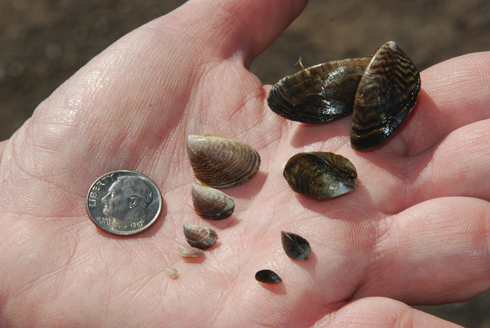I spend a lot of time at boat launches around Walworth County every summer talking to boaters and anglers about the steps they must take to prevent the movement of aquatic invasive species (AIS). I’m happy to report that these days most people are aware that they are required to inspect their boats and trailers and remove all aquatic plants and animals before leaving the launch.
However, there is still some resistance to and/or confusion about emptying the water from their boat, motor, fish, live well, coolers, etc. before getting on the road. In fact, it seems like I usually talk to at least a couple of anglers every week that do not understand that if they are taking fish they have caught home, those fish must be out of water when they leave the launch or shoreline. This means not just the lake water but any water including water from home and even water from melted ice. Of course putting your catch on ice is a great way to keep, them fresh, but if you’re out on the lake all day and some of that ice melts, you must drain that water as well. There are a couple very good reasons you will want to be sure to remember to drain all the water before leaving a launch. The first reason is quite simple, it’s the law and the fines associated with non-‐compliance are fairly steep. Plus we send a big message to our kids, grand kids and other boaters when we follow the laws (or don’t) and we want that message to be positive. Draining the water from our boats, live wells, equipment, coolers and fish will also prevent the spread of Viral Hemorrhagic Septicemia (VHS) and other AIS. Although it does not make people ill, VHS is deadly fish virus that has caused large fish kills in the Great Lakes and the Winnebago system. The Wisconsin Department of Natural Resources (DNR) reports on their website that there are 28 species of fish that are susceptible to VHS, including 19 sport fish. VHS can be spread if infected water or fish are moved from one water body to another. Studies have shown that the virus can remain active in the water for 14 days, which allows ample opportunity for a fish to swim through it and absorb the virus into their gills. Once that fish is infected with VHS, it will shed virus into the water through urine and reproductive fluids within 2 days. Of course a healthy fish may also become infected by eating a smaller infected fish. We want to make sure that VHS is not spread so please never move water or live fish from a water body. Obeying these laws will also help prevent the spread of other AIS that are moved through water. Zebra and Quagga mussel larva are microscopic and can easily be transported to new water bodies if live wells, bilges or other equipment containing water is not emptied. Spiny water flea, which is now found in several popular lakes in Madison, could also be introduced to other lakes through the transport of water. There are many other AIS that we can prevent just by following some very simple prevention steps.
Before leaving any boat launch remember:
• Inspect your boat, trailer and equipment • Remove all aquatic plants, animals and mud from your boat, trailer and equipment
• Remove all aquatic plants, animals and mud from your boat, trailer and equipment
• Drain all water from your boat, motor, fish, livewell and equipment
• Never move plants, water or live fish from a waterbody
It’s The Law
For more information please contact Audrey Greene, Lake Specialist & AIS Coordinator for Walworth County Land Use & Resource Management at
(262) 741-7902 or agreen@co.walworth.wi.us







This is test comment…